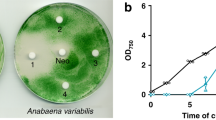Abstract
The broad-spectrum herbicide glyphosate inhibits the growth of Candida maltosa and causes the accumulation of shikimic acid and shikimate-3-phosphate. Glyphosate is a potent inhibitor of three enzymes of aromatic amino acid biosynthesis in this yeast. In relation to tyrosine-sensitive 3-deoxy-D-arabino-heptulosonate 7-phosphate synthase and dehydroquinate synthase, the inhibitory effect appears at concentrations in the mM range, but 5-enolpyruvylshikimate 3-phosphate (EPSP) synthase is inhibited by micromolar concentrations of glyphosate. Inhibition of partially purified EPSP synthase reaction by glyphosate is competitive with respect to phosphoenolpyruvate (PEP) with a K i -value of 12 μM. The app. K m for PEP is about 5-fold higher and was 62 μM. Furthermore, the presence of glyphosate leads to derepression of many amino acid biosynthetic enzymes.
Similar content being viewed by others
Abbreviations
- DAHP:
-
3-deoxy-D-arabino-heptulosonate 7-phosphate
- EPSP synthase:
-
5-enolpyruvylshikimate 3-phosphate synthase
- PEP:
-
phosphoenolpyruvate
- S-3-P:
-
shikimate-3-phosphate
References
Amrhein N, Schab J, Steinrücken HC (1980) The mode of action of the herbicide glyphosate. Naturwissenschaften 67:356–357
Amrhein N, Deus B, Gehrke P, Holländer H, Schab J, Schulz A, Steinrücken HC (1981) Interference of glyphosate with the shikimate pathway. Proc Plant Growth Regul Soc Am 8:99–106
Amrhein N, Johänning D, Schab J, Schulz A (1983) Biochemical basis for glyphosate-tolerance in a bacterium and a plant tissue culture. FEBS Lett 157:191–196
Bode R, Birnbaum D (1981) Aggregation und Trennbarkeit der Enzyme des Shikimat-Pathway bei Hefen. Z Allg Mikrobiol 21:417–422
Bode R, Casper P, Kunze G (1983) Auslösung einer allgemeinen Kontrolle der Aminosäurebiosynthese bei Candida spec. EH 15/D durch Amitrol. Biochem Physiol Pflanzen 178:457–468
Bode R, Melo C, Birnbaum D (1984) Inhibition of tyrosine-sensitive 3-deoxy-D-arabino-heptulosonate 7-phosphate synthase by glyphosate in Candida maltosa. FEMS Microbiol Lett 23:7–10
Boocock MR, Coggins JR (1983) Kinetics of 5-enolpyruvylshikimate-3-phosphate synthase inhibition by glyphosate. FEBS Lett 154:127–133
Carsiotis M, Lacy AM (1965) Increased activity of tryptophan biosynthetic enzymes in histidine mutants of Neurospora crassa. J Bacteriol 89:1427–1477
Gollub E, Zalkin H, Sprinson DB (1967) Correlation of gene and enzymes, and studies on regulation of the aromatic pathway in Salmonella. J Biol Chem 242:5323–5328
Lowry OH, Rosebrough NJ, Fall AL, Randall RJ (1951) Protein measurement with the Folin phenol reagent. J Biol Chem 193:265–275
Millican RC (1970) Assay of shikimic acid. In: Tabor H, Tabor CW (eds) Methods in Enzymology. Academic Press, New York London, vol 17A: 352–354
Mousdale DM, Coggins JR (1984) Purification and properties of 5-enolpyruvylshikimate 3-phosphate synthase from seedlings of Pisum sativum L. Planta 160:78–83
Niederberger P, Miozzari G, Hütter R (1981) Biological role of the general control of amino acid biosynthesis in Saccharomyces cerevisiae. Molec Cell Biol 1:584–593
Roisch U, Lingens F (1974) Effect of the herbicide N-phosphonomethylglycine on the biosynthesis of aromatic amino acids. Angew Chem 13:400
Roisch U, Lingens F (1980) Zum Wirkungsmechanismus des Herbizids N-(Phosphonomethyl)glycin: Einfluß von N-(Phosphonomethyl)glycin auf das Wachstum und auf die Enzyme der Aromatenbiosynthese von Escherichia coli. Hoppe-Seylers Z Physiol Chem 361:1049–1058
Rubin JL, Gaines CG, Jensen RA (1982) Enzymological basis for herbicidal action of glyphosate. Plant Physiol 70:833–839
Steinrücken HC, Amrhein N (1980) The herbicide glyphosate is a potent inhibitor of 5-enolpyruvylshikimate 3-phosphate synthase. Biochem Biophys Res Commun 94:1207–1212
Tanaka A, Ohishi N, Fukui S (1967) Studies on the formation of vitamins and their function in hydrocarbon fermentation. Production of vitamin B6 by Candida albicans in hydrocarbon medium. J Ferment Technol 45:617–623
Author information
Authors and Affiliations
Rights and permissions
About this article
Cite this article
Bode, R., Melo, C. & Birnbaum, D. Mode of action of glyphosate in Candida maltosa . Arch. Microbiol. 140, 83–85 (1984). https://doi.org/10.1007/BF00409776
Received:
Accepted:
Issue Date:
DOI: https://doi.org/10.1007/BF00409776




